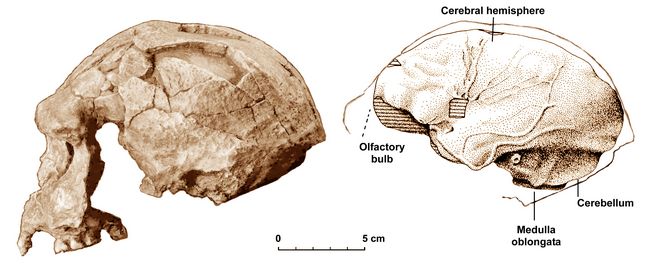Athena Review Image Archive ™
Homo erectus Sangiran 17 skull and brain endocast

Skull and brain endocast of Sangiran 17 from Java (after Holloway 1972, fig.4)
Sangiran 17 was discovered at Sangiran in the Solo River valley of central Java in 1969 by Towikromo. This is the most complete Homo erectus skull found in East Asia, dating from 700,000 years ago. The cranial capacity is estimated at 1004 cc. by Holloway (1981). This is more than twice that of Australopithecus africanus, and almost 2.5 times that of chimpanzees, gorillas, and orangutans. The endocast shows several of the main portions of the cerebrum, including the temporal, parietal, and occipital lobes, as well as meningeal vessels for arteries on the brain's exterior.
The
site of Sangiran was first briefly explored for fossils in 1883 by
Dutch paleoanthropologist Eugène Dubois, who then worked at Trinil in
East Java, where he found the first skull of Pithecanthropus erectus (now Homo erectus). Beginning in 1934 Ralph
von Koenigswald conducted excavations at Sangiran, finding various H. erectus
fossils, including the upper skull portion known as Sangiran 2 (with a
cranial capacity of 813 cc). The site of Sangiran also has many fossils
of animals contemporary with H. erectus.
References:
Holloway, Ralph 1972
Holloway, Ralph 1982
Copyright © 1996-2020 Rust Family Foundation (All Rights Reserved).